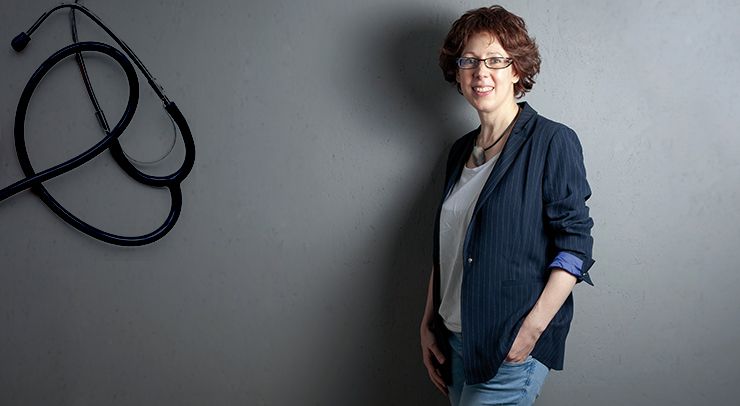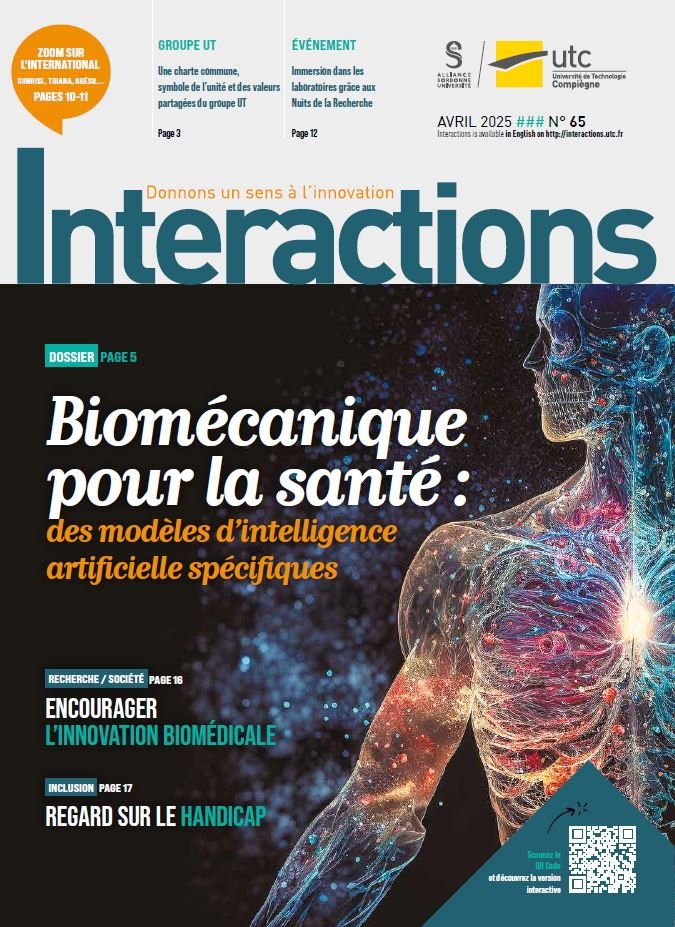A new and patented medical implant device

Like the three musketeers who, as everyone knows, were four, Anne-Virginie Salsac, director of research at the CNRS in the Biomechanics and Bioengineering Laboratory (BMBI), Professor Jean-Paul Couetil and Dr Éric Bergoënd, both cardiac surgeons, and Adrien Laperrousaz,then an engineering student at the UTC, designed an innovative implant for the treatment of functional mitral insufficiency. The implant is already patented nationally and is awaiting approval for a European extension patent.
It all began in 2014 with an e‑mail sent to Cécile Legallais, director of UTC-BMBI, by Professor Jean-Paul Couetil, then head of the thoracic and cardiovascular surgery department, and his colleague, Doctor Éric Bergoënd, both cardiac surgeons at the CHU Henri-Mondor of Créteil. They explained the concept of a new type of cardiac implant and wanted to put their idea into practice with the help of BMBI researchers and engineers. The e‑mail was sent to Anne-Virginie Salsac and led to a meeting to assess the feasibility of the project.
“They were looking for people specialised in biomechanics, with skills in medical device technology and bioengineering, familiar with the world of research and who could collaborate with them. In short, for a research team with the ability to see the needs from a clinical point of view and capable of proposing device ideas, design them and support the project through to completion. It was at a meeting held shortly afterwards that they explained to us the problem of functional mitral insufficiency, its serious consequences from a clinical point of view, particularly on patients who cannot tolerate existing devices”, explains AnneVirginie Salsac.
We therefore had to think about other solutions. “Discovering means defining the problem or issue precisely. They are the ones that, depending on your state of mind, you have the certainty that there will be various possible solutions. It’s up to the team to try to find the best one,” says Jean-Paul Couetil, who has several patents in cardiac surgery to his credit. It’s important to recognize that he’s come from a good school, since he was one of the last students of Professor Alain Carpentier, a leading specialist in mitral reparatory surgery and mitral valve repair at the Broussais Hospital. A field that he continued to explore when he joined the CHU Henri-Mondor in 2010 as head of department.
What reasons led Jean-Paul Couetil and Éric Bergoënd to think about a new system? “There are two types of mitral insufficiency: organic mitral insufficiency and functional mitral insufficiency. In the first case, the mitral valve that is structurally defective. In short, the valvular tissues, pillars or cords attached to the left ventricle which may be defective. In the second case, it is the valve function that is damaged but not the structure itself. A function that may be impaired due to an anomaly in the anatomy of the valve. In principle, the valve allows blood to flow in one direction only from the left atrium to the left ventricle, like a double non-return valve. However, when the two sheets of the valve, for example, no longer come fully into contact during the contraction of the ventricle, some of the blood flows back into the atrium, making the heart less efficient as a pump. This can eventually lead to heart failure, i.e., a severe deficiency of the ventricular muscle. This is all the more critical that some patients cannot tolerate existing treatments”, explains Professor Couetil.
So, how did the idea of a new type of implant come to be? “Professor Couetil’s particularity is to have several ideas per minute. We often discuss pathologies for which existing treatments are either ineffective or too invasive, and how to improve patient care. We have been particularly interested in the treatment of functional mitral insufficiency, which is due to a deterioration in valve function characterised by an imperfect contact between the two leaflets of the valve in systole. It was during discussions on this topic in 2011–2012 that he launched the idea of compensating for this lack of contact by filling the unwanted space between the leaflets with an implantable device; the exact nature of the device had not yet defined,” says Dr Éric Bergoënd.
Until now, the only existing technique for repairing a defective valve in a “minimally invasive” way (transcutaneously, without openheart surgery) consists of placing a small clamp connecting the two valve leaflets in the middle. This promotes improves the contact between the two sheets, but it does disturb the functioning of the valve and the blood flow.
And what about the particularity of the project being carried out within UTC-BMBI…“Once the problem was defined, we thought that the design of a new device consisting of re-establishing the valve’s tightness was an ideal project for setting up a research project for engineering students as part of their training. This is how a project team was set up, bringing together heart surgeons JeanPaul Couetil and Éric Bergoënd, multidisciplinary groups of UTC students (bac+3 to bac+5) and some UTC-BMBI research scientists,” emphasises Anne-Virginie Salsac, adding “We formed groups of 5–6 students who worked on the project over a six-month period. Of course, as lecturer-cumresearch scientists, we monitored the project at regular meetings with them to check that it was moving in the right direction and to provide the students an appropriate level of impetus.”
As a 4th year engineering student in mechanical engineering, Adrien Laperrousaz served, according to Dr Salsac, as a guide throughout the entire project. “Until then, I had only been interested in mechanics in the sense of the science of movement of mechanisms and had never approached the medical field,” says Adrien Laperrousaz. “In February 2014, Anne-Virginie Salsac submitted a CC-project subject (“PR” in UTC jargon) on the dedicated UTC digital workspace around this new mitral valve repair device. I was interested and was selected among the five students for the start of the first PR dedicated to the cardiac implant. I was the only one from mechanical engineering, the other four from bioengineering, and the only one to master the design software to do 3D modelling. This makes it possible to create more meaningful visuals. We then met, accompanied by AnneVirginie Salsac, the two surgeons who described their idea to us and we set to work for five months”, Adrien Laperrousaz explains.
“Once the CC is over, what can you do?” he wondered. All the more so as the four other class mates had left for their final internship. Having taken a liking for what he was doing, he decided to reapply in September 2014. Being the only one present from the beginning and the only one who had mastered the state-of-the-art for this project, we decided to set up several PR groups — one group working on materials, for example; another on the patient status, etc.”, he says. “In January 2015, we realised that we had enough material to put together a dossier and start looking for funding to develop prototypes,” he says.
Thus, in March 2015, Adrien and his colleagues submitted an application to the national I‑Lab competition in the category “Emerging Projects” and were declared laureates, in May 2015. At the end of the competition, they received a grant of 25 000 euros. This allowed UTC to finance Adrien’s final internship at the UTC Daniel Thomas Innovation Centre. “It was in September 2015, during this internship, that I started to develop a prototype implant in order to be able to carry out in vitro tests”, adds Adrien Laperrousaz.
The innovative approach developed by this UTCCNRS team consists in restoring the valve’s tightness by attaching an inflatable balloon to one of its leaflets, via a transcutaneous insert route.
“The creation of a new system is always accompanied by a phase of experimentation. In short, we wanted to see how it works in the most realistic conditions possible. Hence the idea of implanting the prototype in vitro, on an experimental heart model — at University College London (UCL) — which reproduces the flow of blood as in a human heart. The pathologies linked to the mitral valve were also reproduced to be as close as possible to reality. These tests were successful, as there was a real reduction in residual leakage. This enabled us to provide a proof of concept,” describes Anne-Virginie Salsac. What motivated the choice of UTC? “A colleague who has developed several projects in the field of biotechnology advised us to call on the engineers and researchers of the UTC if we wanted this project to succeed. An opinion shared by a teacher-researcher from the École polytechnique whom I had contacted and who gave me the names of Cécile Legallais and Anne-Virginie Salsac. They both praised the dynamism of UTC and assured me that we would find real skills in bioengineering there,” explains Éric Bergoënd. It took a lot of energy for the whole team to come up with such a successful concept and work on the drafting of the patent claim. But the adventure is not over given that a Cifre PhD student, Thibaut Alleau is pursuing — under the supervision of Anne-Virginie Salsac, in partnership with the company SEGULA Technologies — the creation of a digital model of the dynamics of the mitral valve, enabling the positioning of implants to be modelled and tested.




